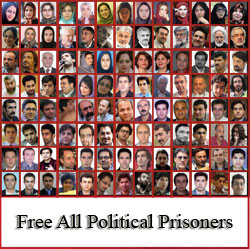537 Hangings From October 2012 To October 2013: A Report On Executions In Iran
From October 11, 2012 to October 10, 2013 at least 537 people were hanged in various cities across Iran. This figure represents a 9% increase in the number of hangings over the same period last year.
Issuing and implementing of death sentences in Iran occur while many of the defendants are not afforded due process and lack proper defense representation.
The following is an excerpt from a Human Rights Activists News Agency report on executions in Iran.
The most controversial execution:
The most controversial execution was carried out with Ayatollah Amoli Larijani, the Chief Judiciary entering the case. Mohamad Ali Sarvari and Alireza Mafiha were hanged in public on January 20, 2013 on charges of assault with a machete. Larijani had made the statement that there was no difference between assault with a cold weapon and firearms and in both cases it should carry the maximum penalty of the death sentence.
The process of issuing and implementing the death sentence for these two defendants took only 20 days. A video of the assault was wildly published online. The public hangings which were carried out in the “Artists Park” met with widespread criticism by local artists and activists alike.
The most controversial site of an execution:
A man named Alyas (approximately 23 years old), convicted of rape, was hanged at Shahid Mazhari sports stadium in the city of Sabzevar. The officials had not placed any restriction on the gender nor the age of the people who were occupying the seats in the stadium to watch the hanging. FIFA responded to the execution in a soccer stadium by sending a protest letter to the Iranian Football Federation.
The most number of hangings in one day:
The most number of executions in one day was carried out on August 22. 2013. On that day, 27 people were hanged in various cities across Iran.
The most number of executions in one province:
The most number of executions were carried out in Alborz province. Due to the three major prisons in this province (Ghezel Hesar, Rejaei Shahr and Karaj penitentiary) it had the high statistics of executions.
The provinces carrying the most number of executions are: Alborz with 93 hangings, Tehran with 42 hangings and Fars and West Azarbaijan with 38 hangings each.
The province with the highest number of public executions:
Fars province carried the highest number of public executions in various cities in the province. 23 people were hanged publicly in this province during this period.
The prison with the highest number of executions:
With 47 hangings, Rejaei Shahr prison holds the highest number of executions statistic, followed by Oromieh with 40 hangings and Ghezel Hesar with 37 hangings.
Statistic on the types of charges:
62% of the executions during this period were convictions on drug charges, 13% were for murder charges and 11% were for rape.
Giving the death sentence to, and execution of juvenile offenders:
The execution at age 18 in Ahwaz Karoon prison of a juvenile offender who was charged with committing murder at age 14, is the most controversial case in this regard.
Also, another juvenile offender named Farhad, who had committed murder at age 17, received the death sentence by Branch 74 of the Criminal Court. At the time of this report, and on the International Day Against the Death Penalty, the Supreme Court upheld the death sentence of Bahaedin Ghasemzadeh who had committed murder at age 16.
The death sentence statistic:
During this period, the Judiciary has sentenced to death 106 people in various cities on charges other than drug charges.
Execution statistic:
During this period (October 2012 until now) 537 people who had received the death sentence were executed.
12% of these hangings (67 people) were hanged in public.
Most of the executions were carried out with minimal transparency in the process and the execution itself to the point that the gender of 61% of those hanged is not known. Only the gender of 19 women and 189 men were disclosed.
Also the identity of 60% of those executed and reported by the judiciary are unknown and only in some cases in which that the hanging was public was the identity those hanged disclosed.
Source: HRANA


